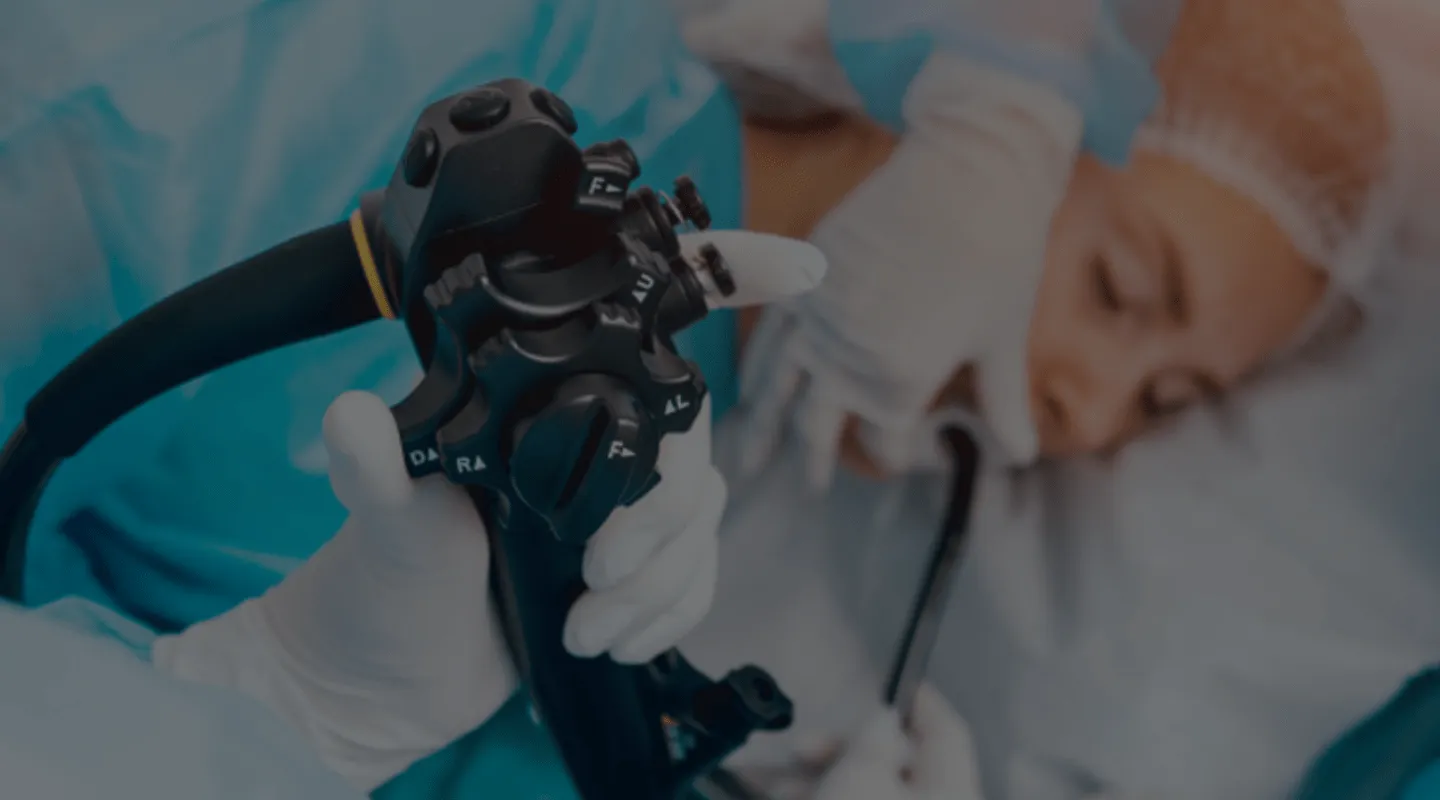
Fibroscopy
Your Affordable Fibroscopy in Tunisia
Get a reliable digestive assessment with a fibroscopy performed in a modern and reassuring medical environment.
How does it work?
Fibroscopy
Gastric fibroscopy or endoscopy allows for in-depth examination of the upper digestive system using a small camera at the end of a flexible tube. This valuable tool is used by gastroenterologists, specialists in digestive system diseases, to diagnose and treat problems affecting the esophagus, stomach, and the beginning of the small intestine (duodenum). Although the procedure is performed under local anesthesia, it can be performed in an outpatient surgical center or in a hospital or clinic for your comfort and safety.
Who is Fibroscopy For?
Fibroscopy may be indicated in a routine health check-up from a certain age.
- Examining symptoms: An endoscopy can help your doctor determine the causes of digestive signs and symptoms, such as nausea, vomiting, abdominal pain, persistent digestive disorders, and digestive bleeding;
- Your doctor can use an endoscopy to take tissue samples (biopsy) to detect various diseases and conditions such as anemia, bleeding, inflammation, diarrhea, or digestive system cancers;
- When you see your doctor, they can use special tools through the endoscope to treat various problems in your digestive system. They can burn a blood vessel to stop bleeding, widen a narrowed esophagus, remove a polyp, or remove a foreign body;
Fibroscopy is sometimes combined with other procedures, such as an ultrasound. Using an ultrasound probe adapted to the endoscope, it is possible to obtain specialized images of the wall of your esophagus or stomach. In addition, an endoscopic ultrasound can be a valuable tool to visualize hard-to-reach organs such as your pancreas, to help your doctor make an accurate and comprehensive diagnosis.
What is the price of a fibroscopy?
It is possible to notice that the cost of a fibroscopy varies depending on the medical establishment chosen. It is important to note that this financial estimate may fluctuate upwards in cases where fibroscopy is combined with other procedures such as a biopsy. These price differences are often due to the increased complexity of medical interventions. When it comes to accurately measuring the value of peace of mind provided by a thorough health assessment, it can be a challenge. However, the choice of a healthcare establishment often reflects a commitment to quality of care, which may justify the necessary budget adjustments.
Your health, our priority.
Request your free quote.
Why have a Fibroscopy?
Fibroscopy, also known as endoscopy, is a valuable medical procedure used to diagnose and sometimes treat various conditions of the digestive system. It allows doctors to directly visualize the inside of the esophagus, stomach, and the first part of the small intestine using an endoscope, a thin, flexible tube equipped with a camera and a light. Common reasons why a fibroscopy may be recommended include persistent symptoms such as abdominal pain, nausea, vomiting, gastrointestinal bleeding, or swallowing difficulties. It is also used to look for causes of severe gastroesophageal reflux, diagnose ulcers, and detect inflammation, infections, or structural abnormalities such as polyps or tumors. In addition to diagnosis, fibroscopy allows biopsies to be performed and certain conditions to be treated, such as the removal of polyps or the dilation of narrowed areas of the esophagus. This procedure is essential for accurate diagnosis and effective management of gastrointestinal problems.
How is a fibroscopy performed?
Fibroscopy is performed on an outpatient basis under general anesthesia. The doctor uses an endoscope equipped with a light source and a camera, which they insert into the patient’s esophagus through the mouth. The images are displayed on a screen, and pictures are often taken and given to the patient with the report. The procedure takes less than 15 minutes.
What are the Risks of a Fibroscopy?
- Bleeding: The risk of hemorrhagic complications after a fibroscopy is increased if the intervention involves taking a piece of tissue for testing (biopsy) or treating a digestive system problem. In rare cases, this bleeding may require a blood transfusion;
- Infection: Most fibroscopies consist of an examination and a biopsy, and the risk of infection is low. It is important to note that the risk of infection increases when additional procedures are included in your endoscopy. Although most infections are minor and can be treated with antibiotics, your doctor may prescribe preventative antibiotics before the procedure if you are at higher risk of infection;
- Gastrointestinal tract tear: If your throat or another part of your digestive system is torn, you may need to be hospitalized and even undergo surgery to repair it. The risk of this complication is very low. By adding additional procedures, such as dilation of the esophagus, the risk increases;
To avoid any complications, it is important to follow your doctor’s instructions exactly for the preparation of an endoscopy, such as fasting and discontinuing certain medications.
What are the signs and symptoms that might indicate complications after a fibroscopy?
After your endoscopy, it is crucial to be attentive to the signals your body may send you. Elements such as fever, persistent chest pain, unusual shortness of breath, difficulty swallowing, or even slight bleeding can occur and should be taken into account. Do not delay contacting your doctor if you notice any of these symptoms. Your well-being is our priority, and any unexpected manifestation must be treated immediately. Rest assured that our medical team will be at your side every step of your health journey.
How to prepare for a fibroscopy?
- Fasting before the endoscopy: To ensure that your stomach is ready for the endoscopy, you will need to stop consuming food and drinks eight hours before the procedure;
- Stop taking certain medications: During your endoscopy, it is important to stop taking certain medications. Anticoagulants can increase the risk of bleeding during fibroscopy procedures. If you suffer from chronic diseases such as diabetes, heart disease, or hypertension, your doctor will give you precise instructions regarding your medications;
Our advantages


Contact and request a quote for a fibroscopy
If you are considering undergoing a fibroscopy as a health check-up or for digestive problems, the Tunisia Destination Santé team is here to help you. Our competent professionals are available to support you from A to Z in all stages of the procedure. We take care of preparing your file as well as organizing your stay. Feel free to contact us to obtain more information and a free, no-obligation quote for your fibroscopy.
—
Frequently Asked Questions
Fibroscopy itself cannot directly detect genetic abnormalities. However, biopsies taken during the procedure can be analyzed later for specific genetic mutations.
Repeated fibroscopy is generally well tolerated, but chronic irritation of the intestinal mucosa can occur, potentially increasing the risk of scarring or ulceration.
Fibroscopy can help diagnose motility disorders by directly visualizing intestinal movements and observing signs of obstruction or stasis.
Fibroscopy can locate the source of bleeding and allow direct interventions, such as cauterization, injection of medication, or placement of clips to stop the bleeding.
The risks of cross-contamination are minimized by rigorous disinfection of instruments, the use of single-use materials, and strict sterilization protocols.
Performing a fibroscopy on a patient suffering from acute respiratory failure is delicate and requires additional precautions. The procedure can be performed under light sedation and with intensive monitoring to minimize risks.
Non-invasive alternatives include video capsule endoscopy, magnetic resonance imaging (MRI) of the intestine, and abdominal CT scan. These methods offer less invasive diagnostic options but may be less accurate for certain conditions.
Fibroscopy is used for regular monitoring of patients with a history of intestinal polyps to detect and remove polyps before they become malignant, thus reducing the risk of colorectal cancer.
Recent developments include high-definition sensor fibroscopes, virtual endoscopy, and the use of artificial intelligence to improve anomaly detection and image analysis.
Fibroscopy is not commonly used for the direct screening of liver diseases, but it can help diagnose gastrointestinal complications associated with liver diseases, such as esophageal varices in patients with cirrhosis.
